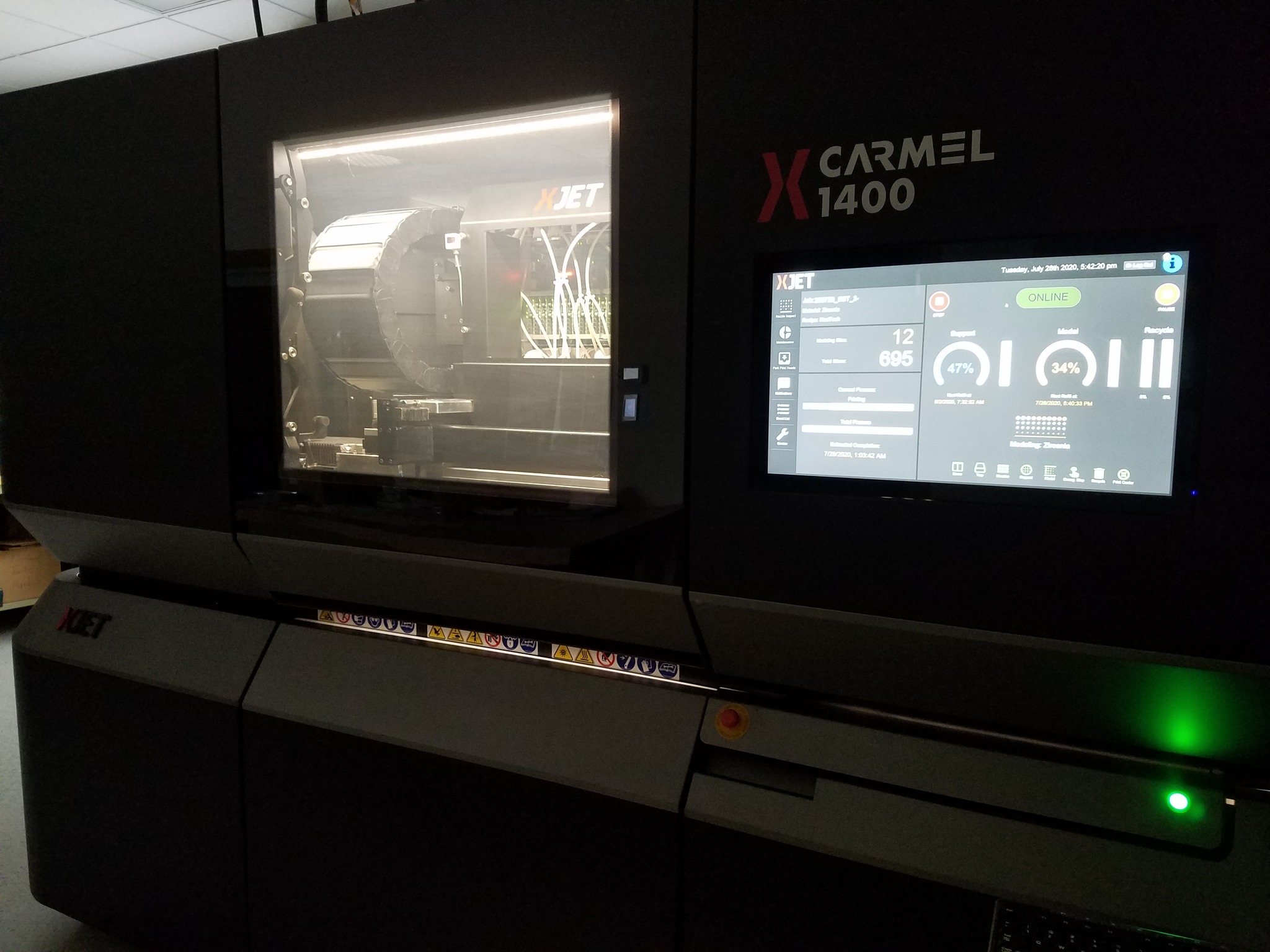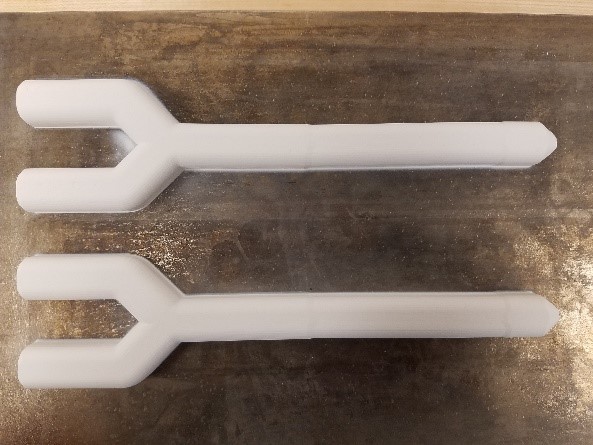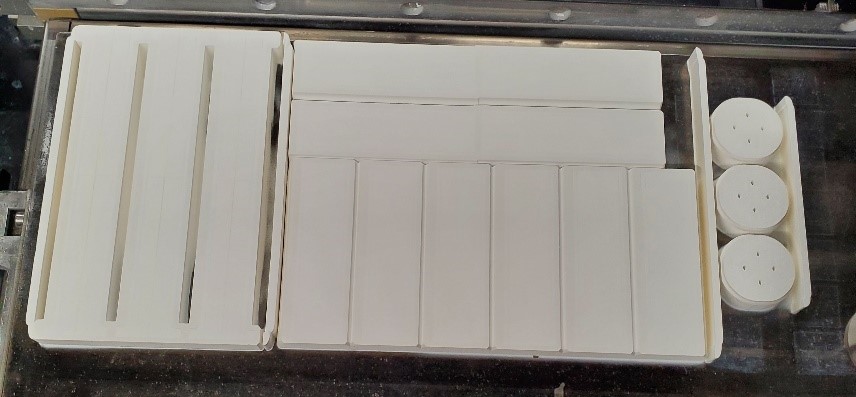Marvel Medtech Advanced Manufacturing offers custom / subcontract additive manufacturing (AM) / 3D printing of advanced technical ceramics. We can transform your complex, highly intricate solid model designs into high-precision ceramic parts with physical, electrical and chemical characteristics that are on par with or better than “legacy” manufactured ceramic parts. With ceramics additive manufacturing, we can produce parts with design complexity and internal features that are not possible with any other manufacturing approach.
Additive Manufacturing (AM), or three-dimensional (3D) printing (3DP), is a relatively new approach to fabricating parts by adding material layer-by-layer in the precise shape of the part. AM is enabled by computer-generated 3D solid models of part designs, and high-precision computer control of 3D printing machinery. There are several different technical approaches used for depositing materials to build-up the part, including FDM (Fused Deposition Modeling), curing of light-sensitive materials with laser tracing, binder jetting and direct material jetting, to name a few. The science and technology of AM / 3DP is rapidly advancing, enabling new techniques and new capabilities for higher precision, new and composite materials, fabricating multi-material electronic components, and medical breakthroughs such as 3D printed biomaterials and customized individual patient-specific implants and prosthetics made from a patient’s medical imaging files.
Marvel Medtech Advanced Manufacturing utilizes the revolutionary patented NanoParticle Jetting (NPJ™) system from XJet Ltd., which offers industry-leading capabilities for dimensional precision and smallest feature-size. XJet NPJ™ is a direct material jetting process that is similar to inkjet printing of text and graphics on paper, but with solid particles of the ceramic material suspended in the liquid ink and jetted through high-precision print head nozzles onto the build tray in ultrathin (10 micron) layers. The heated build tray causes the liquid portion of the ink to quickly evaporate, leaving the solid ceramic particles precisely deposited in place. A water-soluble support ink is jetted at the same time, allowing parts with complex internal geometries to be printed with high accuracy. When printing is completed, the support material is dissolved away in a controlled water bath and the “green” ceramic parts are sintered in the same way as typical / legacy-manufactured advanced technical ceramic parts.
Redefining Ceramics Manufacturing with High-Precision Ceramics Additive Manufacturing / Ceramics 3D Printing
XJet’s NPJ™ technology offers an unprecedented level of accuracy, precision, and flexibility, enabling ceramics additive manufacturing / ceramics 3D printing of advanced technical ceramics parts with complex geometries and intricate internal details that are not achievable with any other ceramics manufacturing approach. Fully sintered advanced technical ceramics parts made with the XJet NPJ™ ceramics additive manufacturing / ceramics 3D printing process have physical and material properties that are on par with or better than parts made with legacy ceramics manufacturing approaches. These new NPJ™ ceramics additive manufacturing / ceramics 3D printing capabilities offer a whole new level of design freedom that is well-suited for demanding technical ceramics part applications such as medical, aerospace, energy, electrical, automotive and many other applications.

Key benefits of advanced technical ceramics parts made with XJet NPJ™ ceramics additive manufacturing / ceramics 3D printing include:
- Unprecedented design flexibility with intricate internal details and ultra-fine features that are not attainable with molding, machining, or other legacy manufacturing approaches
- Ultra-thin 10-micron layers empower industry-leading highest-precision and smallest feature size in advanced technical ceramics additive manufacturing / ceramics 3D printing
- High dimensional precision (±20 microns) with complex internal features and virtually unlimited design geometries including designs with feature sizes down to 100 microns—or smaller depending on design
- Advanced technical ceramics parts made with XJet NPJ™ ceramics additive manufacturing / ceramics 3D printing have isotropic properties that are equal to or better than legacy-manufactured ceramics: 99.9% density, isotropic uniformity, equal or better mechanical. electrical, chemical properties
- Fine grain size of the advanced technical ceramics nanoparticles suspended in ink allows for smooth surfaces and sharp edges as printed
- Highly efficient use of raw materials with minimal waste: Simultaneous jetting of advanced technical ceramic nanoparticles and support material in liquid suspensions delivers unrivaled operational efficiency
Steps Involved in XJet NPJ™ Ceramics Additive Manufacturing / 3D Printing Process
- Pre-processing/file preparation: Our experts will verify the suitability of the customer’s part design for additive manufacturing (DFAM – Design for Additive Manufacturing). Frequently we will make recommendations for design changes that will result in more optimum results from the XJet NPJ™ AM process. The approved part model is positioned onto a model of the printing tray and replicated as needed using NetFabb® software. This print file preparation process also automatically calculates the model scaling required to offset the sintering shrinkage, and the parts are automatically scaled-up to the correct printing size. The printer-ready NetFabb® file is then sent to the XJet Build Engine application, which slices the model digitally into printable layers and uploads the layer segments to the printer as a Print Job file.
- Printing: When the printer is ready and the Print Job file is available, the printer operator initiates the start of the Print Job using the printer’s user interface. The printer / Print Job is monitored for faults, but otherwise the Print Job runs to completion typically without further operator intervention.
- Cleaning: Upon completion of the Print Job and after a cool-down period, the build tray is removed from the printer and placed into a controlled water bath to dissolve the water-soluble support material. The water bath is temperature controlled and monitored for purity, and water is replenished as necessary to maintain effective cleaning of the parts. When all of the support material is dissolved away, the “green” (un-sintered) parts are removed from the water bath and allowed to air dry.
- Sintering: Sintering of the green parts is required to fuse the ceramic nanoparticles into the final form of the part design. This fusing results in shrinkage of the part, resulting in very dense (<0.01% porosity) parts having the desired final dimensions and physical characteristics. The green parts are arranged in a sintering furnace and a sintering program appropriate for the size of the parts and part volume is loaded. The sintering program is started and allowed to run to completion, typically without further operator intervention.
- Quality Assurance: After cooling of the sintered parts, they are inspected according to the Customer’s requirements, then bagged, tagged and shipped.
Our Advanced Technical Ceramics Additive Manufacturing / 3D Printing Capabilities
Marvel Medtech Advanced Manufacturing is one of the first companies in the US to adopt the XJet NPJ™ system for ceramics additive manufacturing / ceramics 3D printing of advanced technical ceramics. As an early adopter, Marvel Medtech Advanced Manufacturing has developed unique, proprietary insights, knowledge, and skill in using the XJet NPJ™ system. We have successfully expanded the capabilities limits of the XJet NPJ™ system through many challenging advanced technical ceramics applications for our customers.

- Advanced Technical Ceramics Materials – The following ceramics materials are currently available for technical ceramics additive manufacturing / ceramics 3D printing using the XJet NPJ™ system:
- Zirconia: TZ-3Y (Tetragonal Zirconia Oxide (ZrO2) partially stabilized with 3 Mol percent Yttria (Y2O3)) – A commonly used formulation known for its high compressive strength, high flexural strength and high fracture toughness.
- Alumina: High-purity (99.9+ %) Alumina Oxide (Al2O3) – Commonly used in high temperature and electrical insulation applications.
- Design for Additive Manufacturing (DFAM): We can provide expert design consultation and guidance to optimize your part design for best AM results.
- Rapid Prototyping: One of the key benefits of the additive manufacturing approach is the capability to produce prototypes of your advanced technical ceramics part designs very quickly without requiring a large investment in specialized tooling.
- Contract Manufacturing: Depending on part size and volume requirements, we can respond to your production requirements for AM of advanced technical ceramics parts, without requiring an investment in specialized tooling.
Key features of the XJet Carmel 1400C system for advanced technical ceramics additive manufacturing / ceramics 3D printing include:
- Print tray size: 500mm x 140mm
- Printable depth up to 200mm may be possible; printing parts up to 100mm in depth is more practical
- Sintering Shrinkage
- Alumina: 14.5% (isotropic)
- Zirconia: 17.8% (isotropic)
Key characteristics of advanced technical ceramics parts produced by Marvel Medtech Advanced Manufacturing:
- Dimensional Tolerances
- Dimensions <50mm: .02-.05mm (20-50 microns)
- Dimensions >50mm: .1mm (100 microns)
- Minimum wall thickness: 0.1mm (100 microns)
- Minimum hole diameter: 0.2mm (200 microns)
- Minimum radius: 0.15mm (150 microns)
- Surface Finish
- Alumina: 0.4 microns
- Zirconia: 20 microns
Popular Ceramic 3D Printed Parts
- Surgical tools
- Dental implants
- High-temperature insulation components
- High-temperature structural supports
- High-temperature bearings
- Heat exchangers for extreme temperature (hot or cryogenic) applications
- Cryogenic applications
- Electrical insulation components
- Laboratory tools and fixtures
- Consumer goods (cutting tools, heat insulation applications)
- Extreme temperature clamps and fixing supports
Contact Us for Your Advanced Technical Ceramics Additive Manufacturing / Ceramics 3D Printing Needs
Our unique expertise in using the XJet NPJ™ technology enables us to handle the most demanding development challenges for advanced technical ceramics. Our ceramics additive manufacturing services / ceramics 3D printing services offering entails working closely with you to understand your application requirements and provide guidance on optimizing part designs for best ceramics additive manufacturing / ceramics 3D printing results. Please visit our Request a Quote for Your Project page to receive a secure link for uploading your solid model file for our review, or contact us at 1-877-345-6261 or 1-608-688-0868 with your questions on advanced technical ceramics additive manufacturing / ceramics 3D printing.

